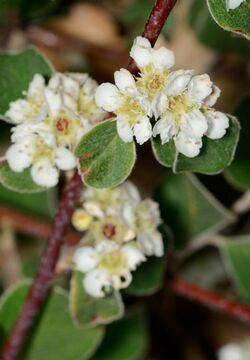Biology:Cotoneaster nummularius
| Cotoneaster nummularius | |
|---|---|

| |
| Nummular Cotoneaster flowers growing in Mount Hermon | |
| Scientific classification | |
| Kingdom: | Plantae |
| Clade: | Tracheophytes |
| Clade: | Angiosperms |
| Clade: | Eudicots |
| Clade: | Rosids |
| Order: | Rosales |
| Family: | Rosaceae |
| Genus: | Cotoneaster |
| Species: | C. nummularius
|
| Binomial name | |
| Cotoneaster nummularius Fisch. & C. A. Meyer
| |
| Synonyms[1] | |
| |
Cotoneaster nummularius, the nummular or coinwort cotoneaster is a species of cotoneaster. This woody shrub is native to much of Asia and south eastern Europe.[2][3][4][5]
Description
Cotoneaster nummularius is a mountainous winter deciduous woody shrub covered in alternate dull green rounded to oval-shaped leaves with fuzzy white undersides and blooms in clusters of 3 to 5 with white hermaphrodite flowers. It flowers from April to June; the fruits are red slightly felted pomes that darken to a bluish black color. It grows at altitudes between 1,400 metres (4,600 ft) to 2,000 metres (6,600 ft).[6][5][4] Sprawling areas of bushes at the base of the Cotoneaster nummularius tree are safe shelters for the Tortoise.[citation needed]
Distribution
The species is found in Greece, Crete, Lebanon, Syria, Israel / Palestine, Turkey, Cyprus, Iraq, Yemen, Oman, Saudi Arabia, Caucasus, Iran, Turkestan, Afghanistan, Tajikistan, Uzbekistan, Azerbaijan, Armenia, Gruziya, Caucasus, Pakistan, Northwestern India, China, Kazakhstan and Kyrgyzstan.[3] The mountains are very young in the Eastern Anatolian region of Turkey. Therefore, the trees in the region multiply with seeds. Due to excessive animal grazing in the area, new shoots of vulnerable Cotoneaster nummularius trees in the open field are eaten by animals. This does not allow them to grow and causes them to take a horizontally irregular shape on the ground.[citation needed]
Uses
Cotoneaster nummularis is used in folk medicine; decoctions made from the fruits is taken orally as an appetite stimulant, stomachic and expectorant.[7]
References
- ↑ GBIF. "Cotoneaster nummularius". Global Biodiversity Information Facility. https://www.gbif.org/species/3025691.
- ↑ Fisch. & C. A. Meyer, 1835 In: Ind. Sem. Horti Petrop. 2: 34
- ↑ 3.0 3.1 Didžiulis V., ed (2014). "Species 2000 & ITIS Catalogue of Life: 2014 Annual Checklist.". Reading, UK.: Species 2000. http://www.catalogueoflife.org/annual-checklist/2014/details/species/id/16791020.
- ↑ 4.0 4.1 "Lebanon FLORA". Faculty of Sciences - Université Saint-Joseph de Beyrouth.. http://www.lebanon-flora.org/species.php?id_pl=372&bp=let&bp_let=c.
- ↑ 5.0 5.1 "Cotoneaster nummularius - Coinwort Cotoneaster". https://www.flowersofindia.net/catalog/slides/Coinwort%20Cotoneaster.html.
- ↑ "Cotoneaster nummularius Fisch. & C.A.Mey. | Flora of Israel Online". http://flora.org.il/en/plants/cotnum/.
- ↑ Arnold, N.; Baydoun, S.; Chalak, L.; Raus, Th. (2015). "A contribution to the flora and ethnobotanical knowledge of Mount Hermon, Lebanon". Flora Mediterranea 25: 48. https://www.herbmedit.org/flora/FL25_013-056.pdf.
Wikidata ☰ Q12233305 entry
 |

